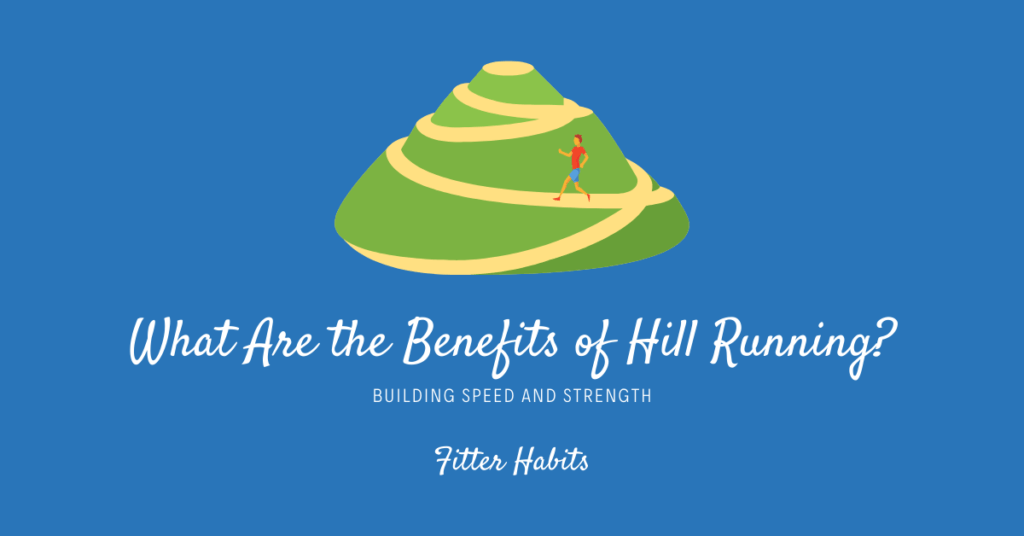If you’re wondering what are the benefits of hill running, it’s building speed and strength.
Runners reading this article may remember a story from a parent or grandparent, “Back in my day I had to walk miles to school uphill…”
Well, even though they were complaining, it turns out that the benefits of hill walking and hill running are pretty amazing.
It’s a useful form of training that helps build up leg muscles. It can also help you unlock more value from speed work. Hill running isn’t always easy, but let’s look at what it can do.
Contents
Health Benefits of Hill Running

Hill running provides many benefits that flat ground running doesn’t offer. You will see quicker results with hill running, and those gains will translate to even better flat running skills and times. Here are just some of the benefits of hill running.
Work Out and Increase Muscle Strength
Uphill running will build strength. If you hate weight training or don’t always have the time to do it, adding hill runs to your cardio can make up for that. You will strengthen your glutes, hamstrings, quadriceps, and it can even improve your core strength and upper body strength.
Muscle Strength doesn’t just benefit from going uphill. You also gain strength with downhill running. Downhill works your stabilizers in your leg muscles, by helping you balance on the descent.
Burn More Calories
Flat ground running can be great, but to burn enough calories, you have to run for a long time. Adding an incline increases your running economy. You will still be putting in all the work, and increasing heart rate. However, you won’t be spending as much time doing it.
Burning more calories will help you with your body weight, which is always a welcome benefit. Whether you’re a distance runner or a sprinter, the increased burning calories will help you stay in shape.
Increase Your Overall Speed
By running at an incline, you increase your race pace. When you go back to a flat ground training plan, you will see that you have become so much faster. This speed increase is caused by the relative ease when running on flat ground instead of an incline.
Gain Better Stamina
If you can run five miles on a hilly race, you can run even further on flat ground. Train on hills regularly, and you’ll see an increase in your ability to run longer with fewer breaks.
The hills increase your heart rate and it will help build up your VO2 max. The increase in stamina can be useful for long-distance runners and when you plan to train for a half marathon.
Reduce Injury
When you strengthen your leg muscles, you reduce risk of injury. Hill running promotes leg, ankle and core strength. It also teaches the runner control over form, all of which can help with injury prevention.
How to Maximize Hill Running
When you are running hills in your training program, you want to ensure that you are using the proper running form. This form helps you get the most out of each workout. It is easy to lose your form when you run hills. When I first did it, I broke all the form rules and ended up regretting it when I got shin splints.
We want to make sure you don’t have the same problems. Here are some tips so that you get the most out of every hill run.
Avoid Leaning at the Waist
It is natural to feel like you have to lean into the hill to run up and down it, but this is not the case. This desire to lean will increase on a steep hill. Like when running on flat ground, stay as straight as you can. Think: “Run tall”.
Extend Your Leg Fully With Each Step
Use your full leg to gain power and move efficiently when climbing a hill. Full motion of movement will give you a full workout. You will gain more benefits from the hill. These benefits are especially true for muscle fibers.
Use Gravity Going Downhill, and Focus on Form

Going downhill is easier. However, ensure you still standing tall. Avoid leaning back or trying to brake or running wildly and madly downhill. Maintain control with your hands by your waist.
If you run downhill a lot or at pace, it can trigger delayed onset muscle soreness (DOMS) afterwards. So, plan an easy recovery run or walk the next day to aid recovery.
Sample Hill Workouts
Hills can be the main focus of your workout, or they can be used as part of fartlek running to help vary your pace. You can try these exercises out on rolling hills, or with your inclined treadmill. Here are some workouts you can try the next time you’re near a hill.
Hill Sprints
Find an area with a few hills. Warm-up with a light jog, then start sprinting at full speed up a hill for 15-30 seconds. The hill gradient should be between 8 to 10 percent. Walk or jog for 2 minutes in between sets. Complete about four rounds. You can incorporate this as part of another run.
Hill Intervals
Start your hill session with a warm-up, then run uphill at an incline of 10-15 percent for one to two minutes. This works best on a long hill.
Aim for three sets, with three to five reps per set.
After a rep, take a one-minute rest. After a set, take a three to five minute rest. This workout helps you increase stamina. That’s about twenty minutes excluding your warm-up and cool down.
Hill Strides
Warm-up, then run up an easy hill as normal. Next, stride downhill, keeping your arms low, spring off your feet and drive your legs forward. Ideally, stride at 80-90% of maximum effort. A single stride covers a meter or so. Focus on form.
A rep should last about 20 to 30 seconds. Aim for between 10 and 20 reps, depending on the gradient and distance.
The Final Word on the Benefits of Hill Running
Hill training can be a lot of fun, and it can help you achieve more of your fitness goals. It’s an excellent way to add strength training to a cardio workout, and can also increase stamina and speed.
When you are running hills with the proper form you can increase many positive attributes that will make you a better runner. Try these exercises to add another layer to your workout routine.



